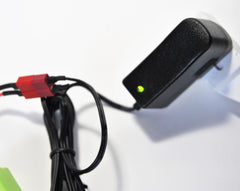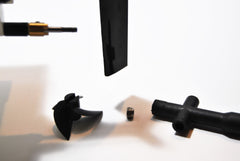CHARGER 2 FAQ
|
Welcome to our FAQ area for LiteHawk CHARGER 2. Simple tips and tricks are just below - check our Overview video for even more info! |

|
LiteHawk CHARGER 2 is a sleek, low profile, twin hull racing boat that follows the design look of classic Off-Shore Racing Crafts! The Motor, ESC and Receiver are all water cooled - protecting them from overheating! This is super important as everything is tightly sealed within the hull - hey, it gets hot in there! The twin-hull design of the CHARGER 2 lifts the boat out of the water at high speed - allowing it to ride on a cushion of air, increasing top speed right up to 25 km/h!
|
|
LiteHawk CHARGER 2 - NIMH Battery and Charger Instructions: STEP 1: Remove the wall plug charger from the package and plug it into the wall. When plugged in a green LED light will come on. STEP 2: Connect the NIMH battery to the charger. The green LED light will turn to red. STEP 3: When the LED indicator light on the charger turns back to green, the battery is fully charged. Charge times are (approx. 2 hrs) do not leave on charge overnight. Battery should be unplugged from the charger after a maximum 3 hours STEP 4: Unplug the battery from the charger and remove the charger from the wall plug. During charging: (Li-Ion Version pre 2015) LiteHawk CHARGER - Charging the 7.4V Li-Ion Battery |
|
LiteHawk CHARGER 2 - Installation of battery into the boat:
- There is a waterproof rubber gasket inserted into the lip where the hull joins the main upper deck. Always make sure it’s secured and in position before reinstalling the upper deck. - Remember to disconnect the battery and remove it after use. Always re-charge a Li-Ion battery if you intend to store the product for more than 24 hours. failure to do so will damage the battery. |
|
LiteHawk CHARGER 2 - Binding the Receiver and Transmitter: If this doesn’t solve the issue you will need to bind the Transmitter to the boat’s receiver. - Switch on the Transmitter, making sure the indicator light is red.
|
|
LiteHawk CHARGER 2 - Changing Propeller |
|
LiteHawk CHARGER 2 - Water-cooled and water-proof electronics: |
|
LiteHawk CHARGER 2 - Flex Shaft Maintenance Your boat is virtually maintenance free, but one thing is vital to the life of the drivetrain. Lubricating the flex shaft keeps your boat running smooth and also acts as a water seal. This keeps water from entering your boat. Lubricate the flex shaft/propeller shaft after every 2-3 times you operate your boat. First, remove the Propeller from the Flex shaft.
|
|
LiteHawk CHARGER 2 - Rudder Assembly Remove the two screws holding the Rudder Assembly to the rear of the CHARGER. With the assembly dangling free, you can manipulate the servo wire out of the.. remember this.. middle hole of the rudder linkage.
Carefully reassemble in reverse order. |
|
LiteHawk CHARGER 2 - Servo/Rudder Linkage Remove the two screws from the bracket holding down the servo, and unplug the servo wires from the ESC. With the servo free of its restaining bracket, you can manipulate the servo from the servo wire. Reassemble in reverse order. |

















